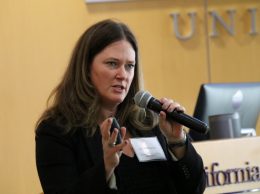Murphy: Dispersed teams can be effective

Susan Murphy
By Susan Murphy
Visit any workplace today and you will likely encounter teams of employees who work from various locations and seldom, if ever, meet face-to-face.
In some industries, the vast majority of workers report always or frequently working in dispersed teams.
Especially in Southern California, where commute times and costs are considerable, the appeal of dispersed teams is undeniable. Alternative work arrangements such as telework and flextime that allow employees more control over when and where they work enhance employee satisfaction.
A dispersed team structure can facilitate work-life balance and benefit the bottom line by accessing the best and lowest-cost global talent.
When surveyed, though, a large percentage of dispersed team members report falling short of their performance goals or failing to satisfy client requirements.
Research shows it is possible for these teams to perform well, and even outperform those that are co-located.
By following a few simple practices you can increase the chances these teams live up to their potential.
Keep it small. Despite company size, the most effective teams tend to be small ones — usually fewer than 10 people. Motivation loss, or social loafing, is the tendency to reduce effort when working with others, and the larger the team, the easier it is to hide lack of effort.
Ensuring effective and inclusive communication as a dispersed team grows is particularly challenging. Increasing size by just a few members — say from 10 to 13 people — results in as much as a seven-fold increase in the number of conversations needed for everyone to touch base. This provides many more opportunities for miscommunication and misunderstandings.
Sync up. The type of communication technology used and the extent to which it makes members feel connected to and aware of other members’ actions impacts group functioning and, ultimately, performance.
Asynchronous communication — such as email, discussion boards and text messages — does not require participants to read and react at the same time and may lack the inclusivity of synchronous communication when all are present such as in teleconferences or virtual meetings.
Many consider virtual communication less productive than face-to-face interaction, and collaboration technology can leave team members feeling confused and overwhelmed. It is paramount, therefore, to select appropriate technologies.
Get to know one another. Relationship building and trust are closely related to face-to-face interactions. While employees in the same office commonly chat informally, the more dispersed the team the less frequent those opportunities.
Managers should employ team-building techniques geared toward a virtual environment such as encouraging members to share their backgrounds or provide video tours of office spaces to allow colleagues to form mental images.
Consider scheduling face-to-face meetings when the team is initially assembled, whenever a new member is incorporated and at regular intervals. Have team members spend time in other’s locations. Build time into synchronous communication for sharing team members’ professional accomplishments or relevant personal news.
Develop explicit rules of the road. For a dispersed team, ensuring that desired norms are adopted is crucial.
In a dispersed environment, managers should take time upfront to understand all team member environments and cultures. It may also be necessary to implement different ways to share individual members’ strengths and weaknesses and develop group identity, norms and accountability practices.
Implementing an explicit, detailed and effective communication plan is imperative. Include the charge to communicate frequently and hold regular meetings, both between individuals and with the entire team. Providing for informal conversations in multiple methods such as instant messaging, phone and videoconferencing should also be included.
Finally, address differences in the ways interpersonal communication manifests in a virtual environment.
For example, being candid and open is a foundation of successful teamwork, and practices may need to be tailored to encourage this among members who have not spent much time together.
Consider designating one team member per meeting to act as a candor advocate tasked with pointing out when members are not being candid or criticism is not being leveled constructively and, on the positive side, recognizing members for practices that improve communication.
Thoughtfully incorporated, these practicescan increase the likelihood that dispersed teams can not only benefit work-life balance and environmental responsibility but also maximize productivity.
• Susan Murphy is a professor in the California Lutheran University School of Management.












